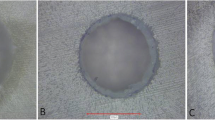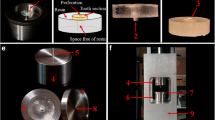Abstract
The aim was to evaluate the influence of different irrigation solutions on the push-out bond strength (POBS) of three different sealers (AH Plus, BioRoot RCS, GuttaFlow2). Root canals of 180 single-rooted human teeth were instrumented with F360 up to size 45.04. All canals were irrigated with 5 ml NaOCl 3% and 5 ml EDTA 17%. The canals were finally irrigated with either 5 ml NaOCl 3%, CHX 2%, EDTA 17%, citric acid 20% or NaCl 0.9% (n = 36) with a contact time of 5 min and obturated using matching gutta-percha cones according to the single-cone technique in combination with one of the sealers (n = 12). After 8 weeks of incubation, the roots were embedded in resin. Two slices of 1 mm thickness were obtained representing the middle third of the root. Dislodgement resistance was measured and POBS was calculated. Specimens were examined under 4× magnification to determine the mode of bond failure. Statistical analysis was performed using two-way ANOVA and Student–Newman–Keuls test for POBS and Chi-square test for the mode of failure. POBS was significantly affected by the factor “sealer” (P < 0.001) and by the interaction “sealer/irrigation solution” (P < 0.01). AH Plus revealed significantly higher POBS than BioRoot RCS and GuttaFlow2 (P < 0.05). The POBS of GutttaFlow2 was not affected by the irrigation protocol (P > 0.05). The POBS of AH Plus was positively influenced by EDTA and NaOCl. EDTA had a negative effect on the POBS of BioRoot RCS. The POBS of GuttaFlow2 was not influenced by the irrigation solutions.


Similar content being viewed by others
References
Hergt A, Wiegand A, Hülsmann M, et al. AH Plus root canal sealer—an updated literature review. ENDO (Lond Engl). 2015;9:245–65.
Fisher MA, Berzins DW, Bahcall JK. An in vitro comparison of bond strength of various obturation materials to root canal dentin using a push-out test design. J Endod. 2007;33:856–8.
Neelakantan P, Sharma S, Shemesh H, et al. Influence of irrigation sequence on the adhesion of root canal sealers to dentin: a Fourier transform infrared spectroscopy and push-out bond strength analysis. J Endod. 2015;41:1108–11.
Donnermeyer D, Dornseifer P, Schäfer E, et al. The push-out bond strength of calcium silicate-based endodontic sealers. Head Face Med. 2018;14:13.
Camps J, Jeanneau C, El Ayachi I, et al. Bioactivity of a calcium silicate-based endodontic cement (BioRoot RCS): interactions with human periodontal ligament cells in vitro. J Endod. 2015;41:1469–73.
Sarkar NK, Caicedo R, Ritwik P, et al. Physicochemical basis of the biologic properties of mineral trioxide aggregate. J Endod. 2005;31:97–100.
Prüllage RK, Urban K, Schäfer E, et al. Material properties of a tricalcium silicate-containing, a mineral trioxide aggregate-containing, and an epoxy resin-based root canal sealer. J Endod. 2016;42:1784–8.
Atmeh AR, Chong EZ, Richard G, et al. Dentin-cement interfacial interaction: calcium silicates and polyalkenoates. J Dent Res. 2012;91:454–9.
Watson TF, Atmeh AR, Sajini S, et al. Present and future of glass-ionomers and calcium-silicate cements as bioactive materials in dentistry: biophotonics-based interfacial analyses in health and disease. Dent Mater. 2014;30:50–61.
Camargo RV, Silva-Sousa YTC, Rosa RPF, et al. Evaluation of the physiochemical properties of silicone- and epoxy resin-based root canal sealers. Braz Oral Res. 2017. https://doi.org/10.1590/1807-3107BOR-2017.vol31.0072.
Accardo C, Himel VT, Lallier TE. A novel GuttaFlow sealer supports cell survival and attachment. J Endod. 2014;40:231–4.
Brackett MG, Martin R, Sword J, et al. Comparison of seal after obturation techniques using a polydimethylsiloxane-based root canal sealer. J Endod. 2006;32:1188–90.
Ozok AR, van der Sluis LW, Wu MK, et al. Sealing ability of a new polydimethylsiloxane-based root canal filling material. J Endod. 2008;34:204–7.
Neelakantan P, Ahmed HMA, Wong MCM, et al. Effect of root canal irrigation protocols on the dislocation resistance of mineral trioxide aggregate-based materials: a systematic review of laboratory studies. Int Endod J. https://doi.org/10.1111/iej.12898 (Epub ahead of print).
Pane ES, Palamara JE, Messer HH. Critical evaluation of the push-out test for root canal filling materials. J Endod. 2013;39:669–73.
Schäfer E, Diez C, Hoppe W, et al. Roentgenographic investigation of frequency and degree of canal curvatures in human permanent teeth. J Endod. 2002;28:211–6.
Collares FM, Portella FF, Rodrigues SB, et al. The influence of methodological variables on the push-out resistance to dislodgement of root filling materials: a meta-regression analysis. Int Endod J. 2015. https://doi.org/10.1111/iej.12539 (Epub ahead of print).
Chen WP, Chen YY, Huang SH, et al. Limitations of push-out test in bond strength measurement. J Endod. 2013;39:283–7.
Oliveira DS, Cardoso ML, Queiroz TF, et al. Suboptimal push-out bond strengths of calcium silicate-based sealers. Int Endod J. 2016;49:796–801.
Gade VJ, Belsare LD, Patil S, et al. Evaluation of push-out bond strength of Endosequence BC sealer with lateral condensation and thermoplasticized technique: an in vitro study. J Conserv Dent. 2015;18:124–7.
Mokhtari H, Rahimi S, Forough Reyhani M, et al. Comparison of push-out bond strength of gutta-percha to root canal dentin in single-cone and cold lateral compaction techniques with AH plus sealer in mandibular premolars. J Dent Res Dent Clin Dent Prospects. 2015;9:221–5.
do Carmo SS, Néspoli FFP, Bachmann L, et al. Influence of early mineral deposits of silicate- and aluminate-based cements on push-out bond strength to root dentine. Int Endod J. 2017;51:92–101.
Carvalho NK, Prado MC, Senna PM, et al. Do smear-layer removal agents affect the push-out bond strength of calcium silicate-based endodontic sealers? Int Endod J. 2017;50:612–9.
Amin SAW, Seyam RS, El-Samman MA. The effect of prior calcium hydroxide intracanal placement on the bond strength of two calcium silicate-based and an epoxy resin-based endodontic sealer. J Endod. 2012;38:696–9.
Abada HM, Farag AM, Alhadainy HA, et al. Push-out bond strength of different root canal obturation systems to root canal dentin. Tanta Dent J. 2015;12:185–91.
Silva EJ, Carvalho NK, Prado MC, et al. Push-out bond strength of injectable Pozzolan-based root canal sealer. J Endod. 2016;42:1656–9.
Gokturk H, Bayram E, Bayram HM, et al. Effect of double antibiotic and calcium hydroxide pastes on dislodgement resistance of an epoxy resin-based and two calcium silicate-based root canal sealers. Clin Oral Investig. 2017;21:1277–82.
Wiesse PEB, Silva-Sousa YT, Pereira RD, et al. Effect of ultrasonic and sonic activation of root canal sealers on the push-out bond strength and interfacial adaptation to root canal dentine. Int Endod J. 2017;51:102–11.
Prado M, Simao RA, Gomes BPFA. Effect of different irrigation protocols on resin sealer bond strength to dentin. J Endod. 2013;39:689–92.
Neelakantan P, Subbarao CV, De-Deus G, et al. The impact of root dentine conditioning on sealing ability and push-out bond strength of an epoxy resin root canal sealer. Int Endod J. 2011;44:491–8.
Aranda-Garcia AJ, Vitorino KR, Chávez-Andrade GM, et al. Effect of the root canal final rinse protocol on the debris and smear layer removal and on the push-out bond strength of an epoxy-based sealer. Microsc Res Tech. 2013;75:533–7.
Leal F, Simao RA, Fidel SR, et al. Effect of final irrigation protocols on push-out bond strength of an epoxy resin root canal sealer to dentin. Aust Endod J. 2015;41:135–9.
Vilanova WV, Carvalho-Junior JR, Alfredo E, et al. Effect of intracanal irrigants on the bond strength of epoxy resin-based a methacrylate resin-based sealers to root canal walls. Int Endod J. 2011;45:42–8.
Shokouhinejad N, Gorjestani H, Nasseh AA, et al. Push-out bond strength of gutta-percha with a new bioceramic sealer in the presence or absence of smear layer. Aust Endod J. 2013;39:102–6.
Carvalho CN, Grazziotin-Soares R, de Miranda Candeiro GT, et al. Micro push-out bond strength and bioactivity analysis of a bioceramic root canal sealer. Iran Endod J. 2017;12:343–8.
Bernardi A, Teixeira CS. The properties of chlorhexidine and undesired effects of its use in endodontics. Quintessence Int. 2015;46:575–82.
Author information
Authors and Affiliations
Corresponding author
Ethics declarations
Conflict of interest
The authors declare that they have no conflict of interest.
Rights and permissions
About this article
Cite this article
Donnermeyer, D., Vahdat-Pajouh, N., Schäfer, E. et al. Influence of the final irrigation solution on the push-out bond strength of calcium silicate-based, epoxy resin-based and silicone-based endodontic sealers. Odontology 107, 231–236 (2019). https://doi.org/10.1007/s10266-018-0392-z
Received:
Accepted:
Published:
Issue Date:
DOI: https://doi.org/10.1007/s10266-018-0392-z




